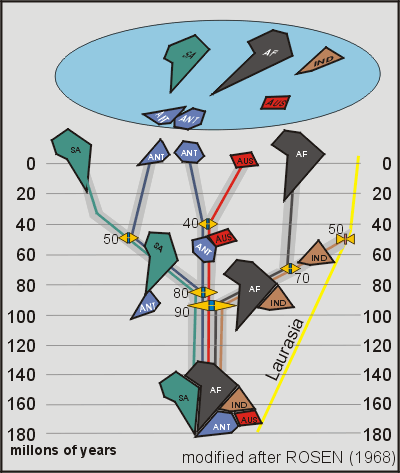Mesozoic Break-Up
The main separation of Ganondwana began about 150 million years ago (Late Jurassic) essentially as a two-plate system, with spreading between western Gondwana (Africa-South America) and eastern Gondwana (Antarctica-India-Madagascar-Australia-New Zealand). The next phase in the break-up was more complex due to simultaneous rifting between Africa and South America and between (Antarctica-Australia) and (India-Madagascar) at about 135-120 Ma (Early Cretaceous). Australia drifted away from Antarctica during the Eocene (about 40 Ma), approximately at the same time as the opening of the Tasman Sea. Seafloor spreading in the Red Sea and the Gulf of Aden did not occur until much later (14-10 Ma). The break-up history of the smaller continental fragments of West Antarctica can be traced back at least as far as the earliest Cretaceous; it is still continuing today with active spreading in the Scotia Sea and in the Bransfield Strait which started rifting in the Pleistocene.
Throughout the southern continents, the intrusion and extrusion of vast volumes of mantle-derived magma, in the form of layered intrusions, sills, dikes and lavas, broadly overlapped in time with the separation history of Gondwana. The Karoo basalts of southern Africa (220-130 Ma, with a peak at ca.190-180 Ma), the Paraná basalts of southern South America (about 120 Ma); the Deccan Plateau basalts of India (65 Ma); and the basalts of Ethiopia (50-0 Ma) are the best known examples for this magmatic activity. This period also coincided with large-scale chemical alteration of the mantle beneath central Gondwana and with an extended period of intermittent kimberlite intrusions (240-60 Ma). There has been a long-standing discussion among earth scientists about a possible cause-and-effect relationship between the breakup of Gondwana, these vast volcano-plutonic igneous provinces, and the associated mantle disturbances.
Following the breakup of Gondwana, new seaways were established between continents. These events had major impacts, not only on the mobility of land and marine fauna, but also on their distribution with respect to changing climates and sea water temperatures. The final separation of Antarctica from all its surrounding fragments, for example, created for the first time a complete circumpolar ocean current, which totally altered the world's ocean-water circulation pattern (www.searchanddiscovery.net/documents/97019/index.htm).
